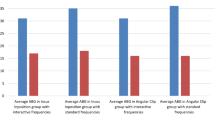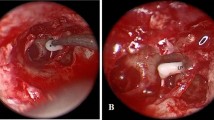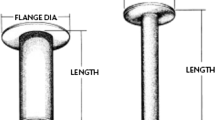Abstract
To compare the outcome of ossiculoplasty using ‘lenticular process of incus replacement prosthesis [LPIRP]’ with that of ‘conventional autologous tissue ossiculoplasty techniques’ in patients with lenticular process of incus necrosis [LPI] in terms of: 1. Hearing results. 2. Graft take-up. 3. Complications like extrusion. Total 16 patients found intraoperatively to have LPI necrosis were allocated randomly using (simple random sampling technique) in two groups. Total 8 patients in group A underwent ossicular chain reconstruction using titanium prosthesis-LPIRP (manufactured by Decibel’s gold prosthesis pvt. ltd.) and total 8 patients in group B underwent ossicular chain reconstruction using autologous cartilage/cortical bone. At the end of 4 weeks status of graft uptake was assessed and follow up pure tone audiogram [PTA] was performed at average 4th, 12th and 24th post-operative week. No significant difference in mean hearing gain (i.e. air-bone conduction gap closure) between two groups at 1 month, 3 months and 6 months post operatively [p > 0.05]. However postoperative 3 months and 6 months results have better air bone conduction gap closure in group A as compared to group B. Titanium LPIRP prosthesis can be a good alternative in patients undergoing ossiculoplasty where autografts are not available for ossicular reconstruction or there is inadequate surgical expertise for remodelling autologous bone/cartilage.
Similar content being viewed by others
Availability of Data and Material
All data used in study was taken from hospital records of patients operated in Department of E.N.T. Head-Neck Surgery, Baroda Medical College, Sir Sayajirao General Hospital with prior approval from ethics committee.
Abbreviations
- LPIRP:
-
Lenticular process of incus replacement prosthesis
- LPI:
-
Lenticular process of incus
- PTA:
-
Pure tone audiogram
- E.N.T.:
-
Ear nose throat
- ABG:
-
Air bone conduction gap
References
Matte U (1901) Uber Versuche mit Ainheilung des Trommelfells an das Kopfchen des Steigbugels nach operative Behandlung chronischer Mittelohreiter-ungen. Arch Ohren Nasen Kehlkopfheilkd 53:9697
Martin AD, Harner SG (2004) Ossicular reconstruction with titanium prosthesis. Laryngoscope 114:61–64
Telian S, Schmalbach C (1996) Chronic otitis media. In: Ballanger’s Otorhinolaryngology head and neck surgery. 16th ed. Hamilton, Ontario: BC Decker Inc., pp 280–282
O’Reilly RC, Cass SP, Hirsch BE, Kamerer DB, Bernat RA, Poznanovic SP (2005) Ossiculoplasty using incus interposition: hearing results and analysis of the middle ear risk index. Otol Neurotol 26:853–858
Kartush JM (1994) Ossicular chain reconstruction. Capitulum to malleus. Otolaryngol Clin North Am 27:689–715
Smyth GD (1982) Five-year report on partial ossicular replacement prostheses and total ossicular replacement prostheses. Otolaryngol Head Neck Surg 90(3 Pt 1):343–346
Naragund AI (2017) Autologous incus versus titanium partial ossicular replacement prosthesis in reconstruction of Austin type A ossicular defects: a prospective randomised clinical trial. J Laryngol Otol 131:391–398
Naragund AI (2011) Ossiculoplasty with autologous incus versus titanium prosthesis: a comparison of anatomical and functional results. Indian J Otol 17(2):75
Acknowledgements
I am thankful to our beloved Head of Department, Dr. Ranjan G. Aiyer, and Associate Professor Dr. Rahul Gupta, for providing me excellent infrastructure for conducting the study. I am also thankfull to Dr.Nikhil Patel, Dr.Jayman Raval, Dr.Hitesh Gangani and Dr.Anand Palas, for encouraging me to involve in research. We thank our statistician, Dr.Vidhi Parmar, for helping us in statistical analysis of the data.
Funding
There was no source of external funding. All expense of prosthesis used in surgery was done by authors.
Author information
Authors and Affiliations
Corresponding author
Ethics declarations
Conflict of interest
All the authors declare that they have no conflict of interest in the submission of this manuscript.
Ethical Approval
All procedures performed in the study involving human participant were in accordance with the ethical standards of the institutional research committee and ethical standards.
Human and Animal Rights
This article does not contain any studies with animals performed by any of the authors.
Informed Consent
Informed consent was obtained from all individual participants included in the study.
Consent for Publication
All authors has given consent for publication.
Additional information
Publisher's Note
Springer Nature remains neutral with regard to jurisdictional claims in published maps and institutional affiliations.
Rights and permissions
About this article
Cite this article
Shah, R.V., Gupta, R.R. & Aiyer, R.G. Comparison of “Lenticular Process of Incus Replacement Prosthesis [LPIRP]” with “Conventional Autologous Tissue Ossiculoplasty Techniques” in Lenticular Process of Incus (LPI) Necrosis. Indian J Otolaryngol Head Neck Surg 72, 492–496 (2020). https://doi.org/10.1007/s12070-020-02017-2
Received:
Accepted:
Published:
Issue Date:
DOI: https://doi.org/10.1007/s12070-020-02017-2




